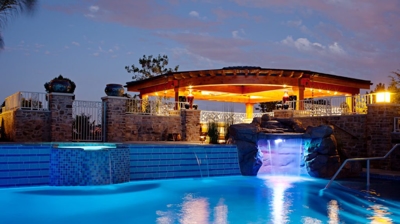To fully experience the long-term upside of having a pool, a watchful eye and regular maintenance is critical. Although a pool can add around 7% to the value of a property, even the most durable surfaces are subject to weather conditions alongside regular wear and tear. Homeowners who stay on top of maintenance will ensure a refreshing oasis that also helps to maximize the overall property investment.
The main question to consider is just how often you should resurface a pool to maintain value and functionality. While there is no set-in-stone time horizon, by knowing the basic guidelines and being proactive, a pool owner can stay a step ahead while warding off potential headaches. Consider the following guidelines while trying to determine when you should resurface your pool.
How Often Should You Resurface a Pool?
Overall, the typical pool has to be resurfaced every 8-10 years, although a range of factors will influence the timetable. The level of sunlight, the chemicals that are used, and the overall maintenance of the pool all come into play. Proper management of the pool might push the range for when it needs to be resurfaced a bit further, but every pool tells a different story.
As a jumping-off point, the pool material is a driving factor for maintenance and pool resurfacing. Here is what to expect based on the different materials used in the typical inground pool.
Vinyl Liners
Vinyl liners are not actually resurfaced, but they do occasionally need to be replaced. The typical range for a vinyl liner is between five and nine years before you should consider replacing it. The reason the range can be this large is because of typical environmental factors like UV rays, chemicals used, and general upkeep.
There is also the possibility of converting from a vinyl liner to a fiberglass pool, though this is rare and typically only considered by those expecting to use the pool for many years (or decades). For the most part, vinyl liners should be closely watched after four or five years for signs of wear and tear. Replacement tends to be straightforward and can be done by the homeowner, but hiring an experienced professional is recommended.
Fiberglass
The gelcoat utilized in a fiberglass pool is extremely durable overall, although it’s also not indestructible. Just like with other surfaces, chemicals and UV rays can degrade it over time, making it important to keep an eye on the integrity of a fiberglass pool surface.
Although fiberglass pools should last decades, it really depends on the specific context and there is quite a bit of range when it comes to resurfacing. If your pool has been receiving prime sunshine for years, alongside basic chemical treatments, it’s a good idea to regularly inspect the fiberglass for signs of distress.
To get a good sense of how well it’s holding up, you’re looking for signs like discoloration, cracking, blistering, or anything else that seems out of the ordinary. It’s also a good idea to fully inspect a fiberglass pool after purchasing a home – especially if information on the pool is limited. If you know a fiberglass pool has been resurfaced within the last decade, you’re likely in the clear for now, although it’s still a good idea to evaluate the pool for signs of damage.
RELATED: The Ultimate Pool Maintenance Cost Guide: Tips and Tricks for Pool Maintenance
If a fiberglass pool has not been resurfaced within the last decade, it might be time for a professional assessment. For homeowners who do see damage, the resurfacing process will likely involve a replacement fiberglass or going with a type of polymer or epoxy.
The quicker you discover damage and make plans to resurface a fiberglass pool, the easier (and cheaper) the process is likely to be. Considering the wide cost range of a fiberglass pool resurfacing, being proactive and catching problems early can save you many thousands of dollars in the long run.
Concrete Pools
Concrete pools come in one of two categories: those with a plaster surface and those using tile/stone to complete the look. Plaster with concrete is the classic inground pool combination, as it is very customizable and built to last. As you approach the 10-year mark, however, it’s likely time to take a closer look for plaster damage that might indicate it’s time for resurfacing.
Many pool owners also go with a tile or stone outer surface to complete the look of a concrete pool. While tile and stone can complete the pool aesthetic in dramatic fashion, they also tend to last about 8-12 years before they need resurfacing or repair.
As always, the expected time horizon is only a starting point; a pool owner should never downplay or ignore damage simply because they weren’t expecting to resurface the pool yet. If you think it’s too early for a full resurfacing, yet see some minor damage, you might be able to have it repaired for much less than it would cost if you let the issue go untreated.
Other Factors that Change Your Resurfacing Time Horizon
UV rays and chemicals slowly degrade a pool’s surface, but there are other factors that will contribute to how often you should resurface a pool. Making sure your pool is appropriately cleaned on a regular basis is a fundamental step that can improve a pool’s long-term outlook. The same goes for ensuring the pump and filter are working correctly to ward off algae growth.
It’s also critical to use the correct types of cleaning tools that fit your pool surface. As an example, a wire brush can cause significant damage to a vinyl or fiberglass pool, yet it can be very effective on a concrete pool. Regularly shocking a pool to eliminate contaminates is another important part of regular upkeep that will pay dividends over the long haul.
Pool owners can also take other proactive steps that might be able to extend the time before a resurfacing is needed. In many circumstances, stripping old paint and using epoxy paint is one alternate option that can improve the durability of a fiberglass or concrete pool. Properly painting a pool’s surface – when the underlying surface is structurally sound – can help a pool owner avoid resurfacing for years.
How Do You Resurface a Pool?
Whether you plan to do it yourself or hire a pro, it’s good to know the basics of what goes into pool resurfacing. While vinyl liners are typically just replaced, concrete and fiberglass pools require a little more of an involved process.
For concrete surfaces, the process typically involves draining the pool to look for cracks or serious damage. Any structural issues are addressed first. Once that stage is complete, it’s on to sandblasting the old plaster until you’re down to the underlying concrete that forms the base of the pool.
After all loose plaster is removed, the surface can be prepared for a new layer of plaster, which is then bonded to the concrete base. During resurfacing, a pool owner gets a chance to choose the type of material that will create the new surface.
While a fresh layer of plaster is typical, the look can be completed with different finishing materials. Both quartz and pebble, for example, are excellent-looking options that also have long lifespans. For a plain plaster bottom, painting the plaster – specifically with epoxy paint – will add durability and longevity.
RELATED: What You Need to Know About Financing a Swimming Pool
When it comes to fiberglass pools, the process also begins by draining the pool and closely examining the structural integrity. In most cases, the pool is completely sanded down to prepare a new surface, which can be a new gelcoat but is often an epoxy or polymer. While epoxies might be able to be installed by a pool owner, polymers are very difficult to install without experience.
But even for pool owners used to the DIY approach, extreme caution is recommended before attempting any pool resurfacing on your own. In nearly every case, hiring a professional local team will be well worth the cost in the long run and will get your pool up and running much faster.
Choosing the Right Company to Resurface a Pool
As with any home maintenance project, make sure that you research and vet the company that will resurface your pool. Select a company with extensive pool installation experience and one that also has experience handling the type of resurfacing project you’re ready to move forward with.
Beyond personal recommendations, you’ll want to look for a local service with professionals who have knowledge of the climate as well as regulations in your area. Remember to check out the Better Business Bureau, social media, and other online reviews to get you started. Although anyone can occasionally get a negative review, it’s likely a red flag if you see the same issue repeatedly.
Once you have narrowed down your options, reach out to the company directly to ask for more information, estimates, and general guidelines of what the project will look like. When undertaking this stage, having a basic knowledge of the resurfacing process will be enormously beneficial.
Finally, you’ll want to compare prices and make sure you’re getting a reasonable rate for your pool type in relation to the geographical area. It can also be helpful to research the value of a pool in your region, as this will give you a general guide to understanding how much you should be willing to spend on the project. Instead of looking at a pool resurfacing as a sunk cost, homeowners should consider pool resurfacing as part of a long-term investment that adds both intrinsic and real-world value to the property.
It’s also important to understand the different ways that a company might charge for a pool resurfacing. Many professional services will charge per square foot and the exact price will depend upon materials, geographical location, and expected labor hours. The right company will be able to outline the costs of labor and materials beforehand to give you a firm idea of the project long before anything moves forward.
Resurfacing Your Pool with Confidence
The more you know about pool resurfacing the better equipped you will be to handle the process. Although pool resurfacing is a straightforward and common procedure in the hands of a professional, knowing the ins and outs can give you the perspective needed to decide the right path. And even if it’s tempting to try a DIY repair or resurfacing to keep costs down, this can be risky and often costs you even more in the long term.
California Pools is a recognized leader in the pool industry. Since 1952, we’ve been serving customers by helping them make educated, informed decisions and then making their pool vision a reality. Whether you need a brand new custom pool, a remodel, or a resurface, we can help. Contact us today to talk to a local team ready to handle the specifics of your project.



